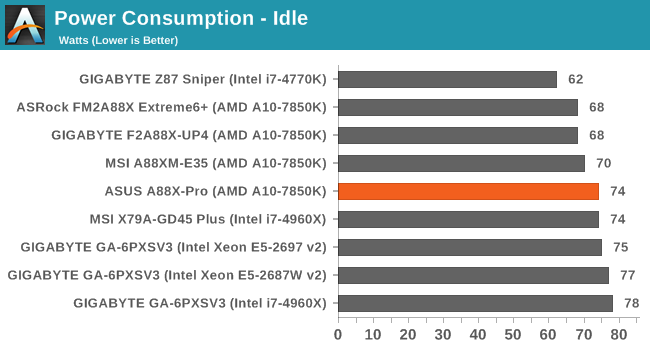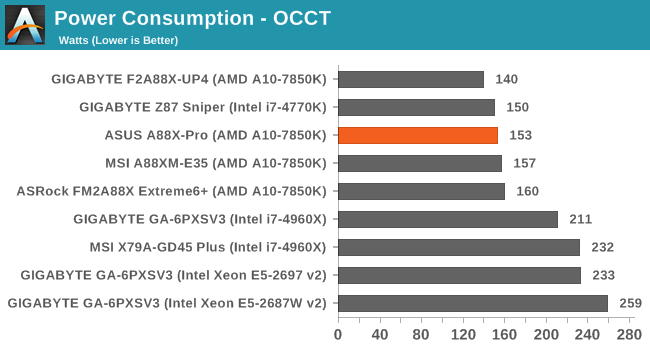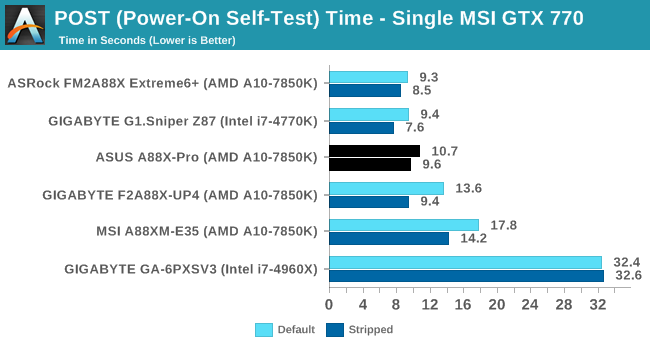ASUS A88X-Pro Review: Kaveri, Kaveri, Quite Contrary
by Ian Cutress on April 22, 2014 11:59 AM EST- Posted in
- Motherboards
- AMD
- Asus
- Kaveri
Many thanks to...
We must thank the following companies for kindly providing hardware for our test bed:
Thank you to OCZ for providing us with 1250W Gold Power Supplies and SSDs.
Thank you to G.Skill and ADATA for providing us with memory kits.
Thank you to Corsair for providing us with an AX1200i PSU, Corsair H80i CLC and 16GB 2400C10 memory.
Thank you to ASUS for providing us with the AMD HD7970 GPUs and some IO Testing kit.
Thank you to MSI for providing us with the NVIDIA GTX 770 Lightning GPUs.
Thank you to Rosewill for providing us with the 500W Platinum Power Supply for mITX testing, BlackHawk Ultra, and 1600W Hercules PSU for extreme dual CPU + quad GPU testing, and RK-9100 keyboards.
Thank you to ASRock for providing us with the 802.11ac wireless router for testing.
Test Setup
| Test Setup | |
| Processor |
AMD A10-7850K (ES) 2 Modules, 4 Threads |
| Motherboards | ASUS A88X-Pro |
| Cooling |
Corsair H80i Thermalright TRUE Copper |
| Power Supply |
OCZ 1250W Gold ZX Series Corsair AX1200i Platinum PSU |
| Memory |
AMD Gaming 2x8GB DDR3-2133 10-11-11 Kit 2 x Corsair Vengeance Pro 2x8 GB DDR3-2400 10-12-12 Kit |
| Memory Settings | XMP |
| Video Cards |
MSI GTX 770 Lightning 2GB (1150/1202 Boost) ASUS HD7970 3GB (Reference) |
| Video Drivers |
Catalyst 13.12 NVIDIA Drivers 332.21 |
| Hard Drive | OCZ Vertex 3 256GB |
| Optical Drive | LG GH22NS50 |
| Case | Open Test Bed |
| Operating System | Windows 7 64-bit SP1 |
| USB 2/3 Testing | OCZ Vertex 3 240GB with SATA->USB Adaptor |
| WiFi Testing | D-Link DIR-865L 802.11ac Dual Band Router |
Power Consumption
Power consumption was tested on the system as a whole with a wall meter connected to the OCZ 1250W power supply, while in a single MSI GTX 770 Lightning GPU configuration. This power supply is Gold rated, and as I am in the UK on a 230-240 V supply, leads to ~75% efficiency > 50W, and 90%+ efficiency at 250W, which is suitable for both idle and multi-GPU loading. This method of power reading allows us to compare the power management of the UEFI and the board to supply components with power under load, and includes typical PSU losses due to efficiency. These are the real world values that consumers may expect from a typical system (minus the monitor) using this motherboard.
While this method for power measurement may not be ideal, and you feel these numbers are not representative due to the high wattage power supply being used (we use the same PSU to remain consistent over a series of reviews, and the fact that some boards on our test bed get tested with three or four high powered GPUs), the important point to take away is the relationship between the numbers. These boards are all under the same conditions, and thus the differences between them should be easy to spot.



Power consumption on the A88X-Pro is in line with other motherboards, however the IR355x ICs of the GIGABYTE seem to have the advantage during high CPU loading.
Windows 7 POST Time
Different motherboards have different POST sequences before an operating system is initialized. A lot of this is dependent on the board itself, and POST boot time is determined by the controllers on board (and the sequence of how those extras are organized). As part of our testing, we are now going to look at the POST Boot Time - this is the time from pressing the ON button on the computer to when Windows 7 starts loading. (We discount Windows loading as it is highly variable given Windows specific features.) These results are subject to human error, so please allow +/- 1 second in these results.

With the focus on fast booting into Windows 8, there is little incentive to optimize the POST sequence for other OSes. Nevertheless we see that a good ~1/3 of ASUS’ boot time can be saved by disabling unwanted controllers.










34 Comments
View All Comments
duploxxx - Tuesday, April 22, 2014 - link
hmm, lets see in results with mid lvl gpu its actually very close to the intel ones. Other cpu benchmarks are pure synthetic and useless for daily tasks or observations. so yeah you are right there is no usecase for narrow minded peopleBucky_Beaver - Tuesday, April 22, 2014 - link
Hmm so Adobe After Effects are useless for daily tasks or observations? Good to know, I guess..CHADBOGA - Tuesday, April 22, 2014 - link
Yeah the best way to judge a CPU's performance, is clearly in a GPU limited benchmark.coburn_c - Tuesday, April 22, 2014 - link
AMD doesn't care about black processors. erm.. performance... AMD doesn't care about performance processors. So I no longer care about AMD. Sad day but like with an addict you have to draw a tough line.The_Assimilator - Tuesday, April 22, 2014 - link
There is one feature that might cause someone to buy an AMD system over Intel - namely, 8x SATA3 ports vs's Intel's 6. So what does ASUS do? They go and waste two of those ports on eSATA. Good job ASUS designers, do you know what would be even better? A D-SUB connector in 2014... oh wait.Alexvrb - Wednesday, April 23, 2014 - link
The eSATA ports are way more useful to me than a couple of extra internal connectors, especially in a pedestrian FM2+ configuration. This isn't meant for a server. There are other FM2+ boards if you are building a NAS or home server. I have never needed that many internal drives on any regular user-facing box (again, not a server).fteoath64 - Thursday, April 24, 2014 - link
Great points!. Yes, 8 sata internal connectors would be a great way to go as many users would want a home server NAS system. However, here is one opportunity where AMD is missing. Getting into that market with several Kaveri variants that has far more value that Gpu grunt and HSA features. It is power savings and using heterogenous cores. Picture this, a Kaveri with 2 SR cores and 4 puma cores with ability for SR cores to be powered off! And all GCN but one core active at low power (eg 200MHz). This is the NAS mode and should not pull more than 25w TDP. So while gaming, one SR core pushes 4.5Ghz, second SR core doing 3.6Ghz while puma cores running 2.5Ghz doing I/O and caching. We really want dynamic TDP adjustment at the BIOS level to manage the system.abufrejoval - Tuesday, April 22, 2014 - link
In these days of "device" craze, it's easy to forget what a PC is all about: Expandability!And what these boards offer are mainly slots: Lots of usable, unhampered, wide slots, which you can use for everything that fits inside!
Not just graphics!
Ok, so you ask: "What's there that still needs to be fit, when everything is already on-board?"
And I say: "Things to come, things which aren't commodity yet!"
And since that's my job, evaluating these things for our corporate data centers, that's what I do: Play around with (what used to be) new stuff like FusionIO, 10Gbit Ethernet, GPU compute etc.
And in that environment I've come to like these AMD APU boards with plenty of wide slots and ports as well as IOMMU support, lots of RAM capacity and mostly even with ECC support.
I run them in my home lab taking the "goods" like FusionIO SSDs, 10GB NICs etc. temporarily from my corporate test lab to my home lab, where experimenting is often a lot faster, with open cases under my desk instead of rack-mount servers inside the computer room.
But I also use them to run as ordinary home servers, where 8 SATA ports, plenty of RAM, good-enough CPU and GPU also allow for very flexible yet quiet servers I an afford to run 24x7 on my home power bill.
They are very, very flexible, which of course also means they aren't perfect at anything: They aren't the lowest power or highest performing systems which I'd need and use in *production*. But when you want "Lego"-like flexibility to try things out, they are really great and very affordable.
And now I'm ready to start with my griping:
AFAIK there are none of the stupid (well actually Intel would think them smart...) limitations that Intel's chipsets have on AMD's platform: Where Intel used to give you only 16 usable PCIe lanes off the CPU, but only allowed you to use them for a GPU (early Intel variants shut off on-board graphics if you inserted a PCIe x8 RAID controller into the CPU slot!) AMD never knew such restrictions. On Intel such things as "bifurication", which is nothing but splitting the 16 lanes into two pairs of 8x, are *luxury* you need to pay at least by going to a Z-chipset, or if you actually would like to combine it with VT-D aka IOMMU best with a C-chipset, of course only combinable with server CPUs.
I'll save you the gory details on the Intel side, most likely you are painfully aware of them anyway.
But with AMD, AFAIK, these limitations do not exist: You can put plenty of 16x slots on your board and while the total number of lanes is of course also fixed by what the CPU/APU supports, the allocation to slots and integrated devices is pretty flexible: The more cards you actually insert, the lower the number of lanes per slot. On the other hand with PCIe 3.0 even a single lane is rather OK for a 10Gbit NIC.
Yet I find that with these FM2+ board, which should not suffer the Intel restrictions, those very same restrictions are *replicated*!
Please correct me if I am wrong, but I believe there is no reason, why you shouldn't be able to buy an FM2+ board with 3x PCIe x16 slots, which should work with 8/8/4 PCIe 3.0 out of the box (perhaps 8/4/4 3.0, which still beats the pants off most entry level Intel offerings): Yet you simply can't have it, unless you go to one of these "Pro" boards.
On the Intel side, yes the 100% price uplift vs. entry would be "justified" by having to resort to some sort of PLX PCIe bridge, but on AMD?
On the Intel side, yes, the 3rd slot would be "not recommended" for anything requiring serious bandwidth, because no matter what how many lanes or what speed you'd see at the slot, it would still have to pass through a 4x PCIe 1.0 bottleneck between CPU and what's left of the South Bridge.
But for an AMD board to down-grade to PCIe 2.0 or even 1.0 on the 3rd slot seems more like "feature emulation" than a technical requirement!
So why is there this "Pro" price gap, "emulating" a similar gap on the Intel side, *when there is no reason beyond marketing?*
Of course I understand why ASUS and their fellow competitors are doing this, but could Anandtech kindly expose that nonsense and discreetly step on some toes?
I don't actually mind paying a little premium to have more usable 16x PCIe slots as well as a generally higher quality motherboard.
But since my use case isn't trying to emulate an Intel 2011 based gaming rig on the the cheap, I'm not nearly as concerned about overclocking as I am about idle power consumption or plain old stability (and that would include ECC support, please, pretty please!)
And on these "Pro" motherboards everything screams about "burn but don't melt" not about "cool and will last forever".
And Anandtech not mentioning power consumption even with a single word, leads me to believe that whoever is using these boards, doesn't have power efficiency on his mind. I've achieved 18Watts on idle desktop using Richmond APUs on ASUS motherboards and I think that's "allright" even if Intel's BayTrail SoCs can scratch 10 Watts off that score. 40+ Watts, however, would signal a resounding "no-go".
Acceptable power efficiency is *exactly* why I'd by one of these: The ability to replace a DL980 class server for quite a few of my virtualization, solid state storage and SDN experiments, while it delivers a home-server and even a 24x7 desktop including some "shoot-them-up" before signing off.
Yes it wouldn't be best at anything, but it would a do a darn good job at replacing quite a few "optimal" systems for the things I do: Great value for an affordable price!
mikato - Wednesday, April 23, 2014 - link
Wow, I completely agree. Nice comment. I remember getting 2 full x16 PCI express lanes on my motherboard, and plenty of SATA connectors when I built my Phenom II X4 965 machine. I told a couple friends who built Intel and they were surprised. Well, Intel is artificially limiting things for price segmentation power, that's just the way it is.mattgmann - Tuesday, April 22, 2014 - link
Dear AMD, Intel, Nvidia and to whomever else this may concern.Please come up with new naming schemes for your motherboards/chipsets/processors/gpus etc. The practice of enumerating your products very closely to that of your competitors is stupid. And though you may claim it to be coincidence, or just following your historic naming schemes, your are lying.
It is not a coincidence that Intel offers the Z87, and AMD the A88X. I am too many scotches deep to provide more examples in this rant, but they abound. It's a crappy marketing practice and just a sign of lazy and uncreative work in their respective departments.
P.S. If any of these companies would like help giving their products creative, attractive names that their intended clientele can relate to, such as "Under the desk dustbox Xtreme", "Mom's basement Earthquake Generator", "Better than apple in an Ironic way (hipster edition)", or perhaps "Extra Core Overcompensator (AMD special)"... Please feel free to contact me, or one of my minions.